11 Best Product Roadmap Tools for Product Teams
Explore 11 top product roadmap tools that enhance team alignment and efficiency, from AI-driven insights to visual planning solutions.
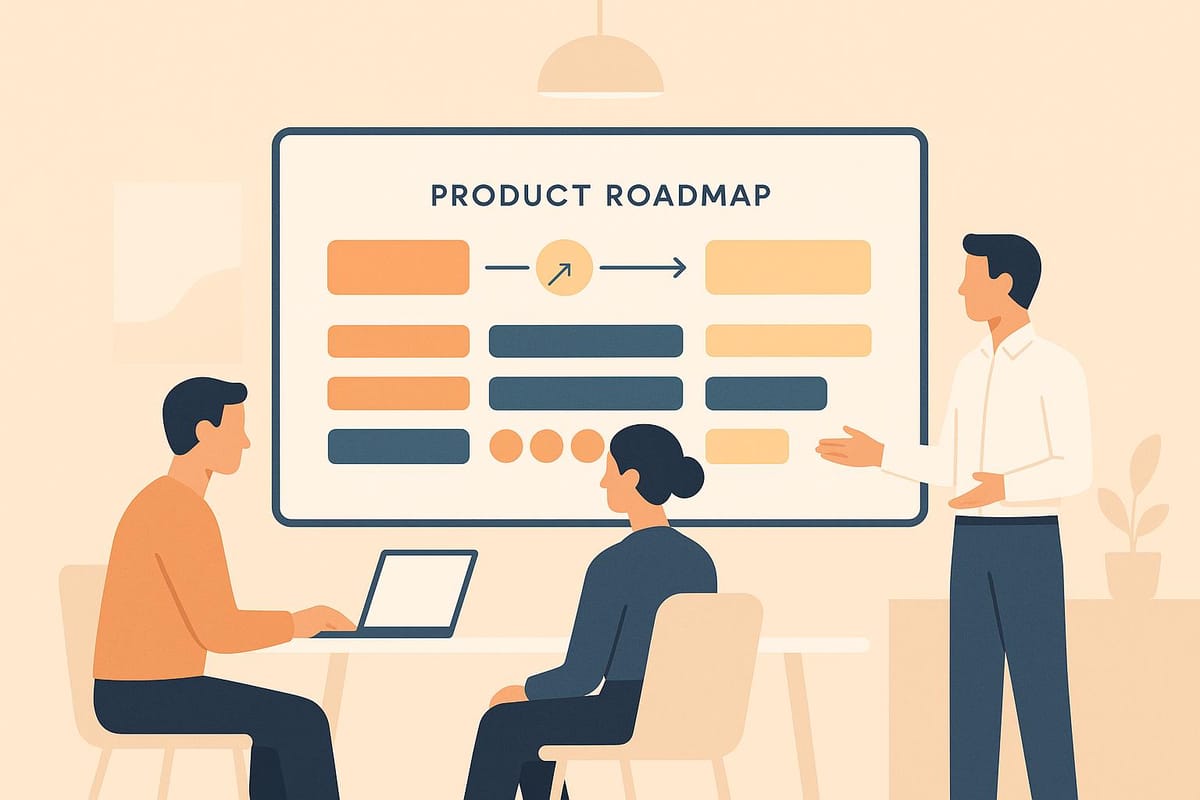
Looking for the best product roadmap tools to keep your team aligned and efficient? Here's a quick guide to 11 tools that help product teams plan, prioritize, and execute better. These tools range from AI-driven platforms to simple, visual roadmapping software, catering to various team sizes and needs. Whether you're a startup or an enterprise, there's a tool on this list for you.
Key Highlights:
- AI-Powered Tools: BuildBetter.ai leads with advanced AI for insights and automation.
- Customer Feedback Integration: Productboard and ProdPad focus on turning feedback into actionable plans.
- Visual Planning: Roadmunk and ProductPlan offer clean, presentation-ready roadmaps.
- Strategic Alignment: Aha! and Jira Advanced Roadmaps excel at connecting goals with execution.
- Flexible Pricing: Tools like Asana and Visor provide affordable entry points for smaller teams.
Quick Comparison:
| Tool | Starting Price | AI Features | Integration Highlights | Best For |
|---|---|---|---|---|
| BuildBetter.ai | $7.99/month | Advanced AI | Zoom, Slack, Jira, Salesforce | Data-driven roadmap insights |
| Productboard | $25/month | Basic AI | Jira, Slack, Salesforce | Customer feedback integration |
| Aha! | $74/month | Limited AI | Jira, Azure DevOps, Slack | Enterprise-level strategic planning |
| Roadmunk | $19/month | None | Jira, Trello, Azure DevOps | Visual-first roadmap presentations |
| ProdPad | $24/month | Basic AI | Jira, Slack, Intercom | Idea and feedback management |
| Airfocus | $19/month | AI Priority Scoring | Jira, Slack, Zapier | Flexible prioritization frameworks |
| Craft.io | $39/month | None | Jira, GitHub, Slack | Teams needing detailed specifications |
| Asana | $13.49/month | AI Automation | Slack, Salesforce | Managing multiple projects across teams |
| Visor | $20/month | Basic Automation | Google Sheets, Airtable | Spreadsheet-style planning |
| ProductPlan | $49/month | None | Jira, Slack, Zapier | Simple and clear roadmaps |
| Jira Advanced Roadmaps | $7.16/month | None | Atlassian suite, Slack | Development-heavy teams |
Each of these tools offers unique features tailored to specific workflows. Start with free trials to find the one that fits your team's goals and challenges.
Top ProductBoard Alternatives | Best Roadmap Tools for Product Teams
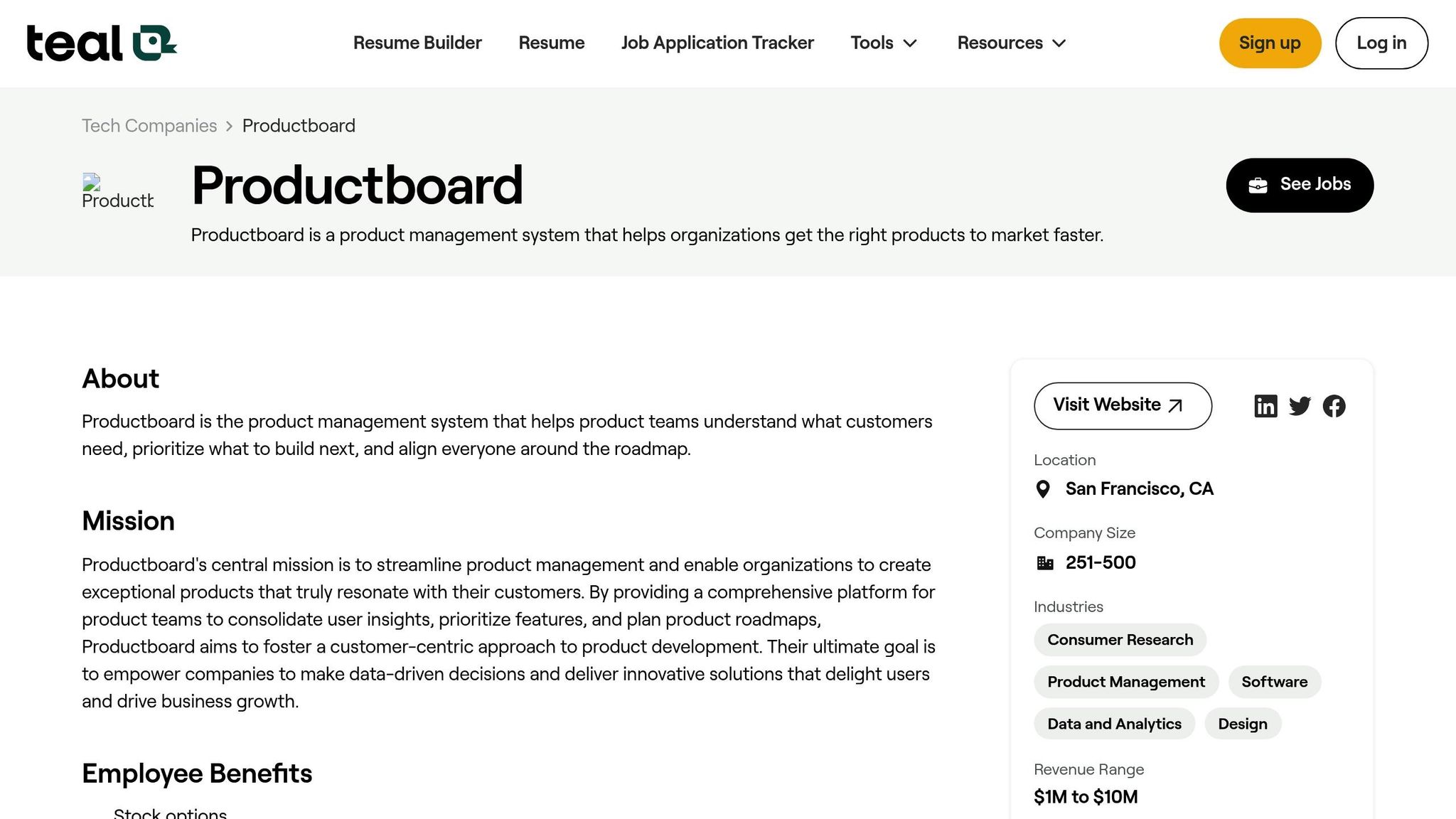
1. BuildBetter.ai
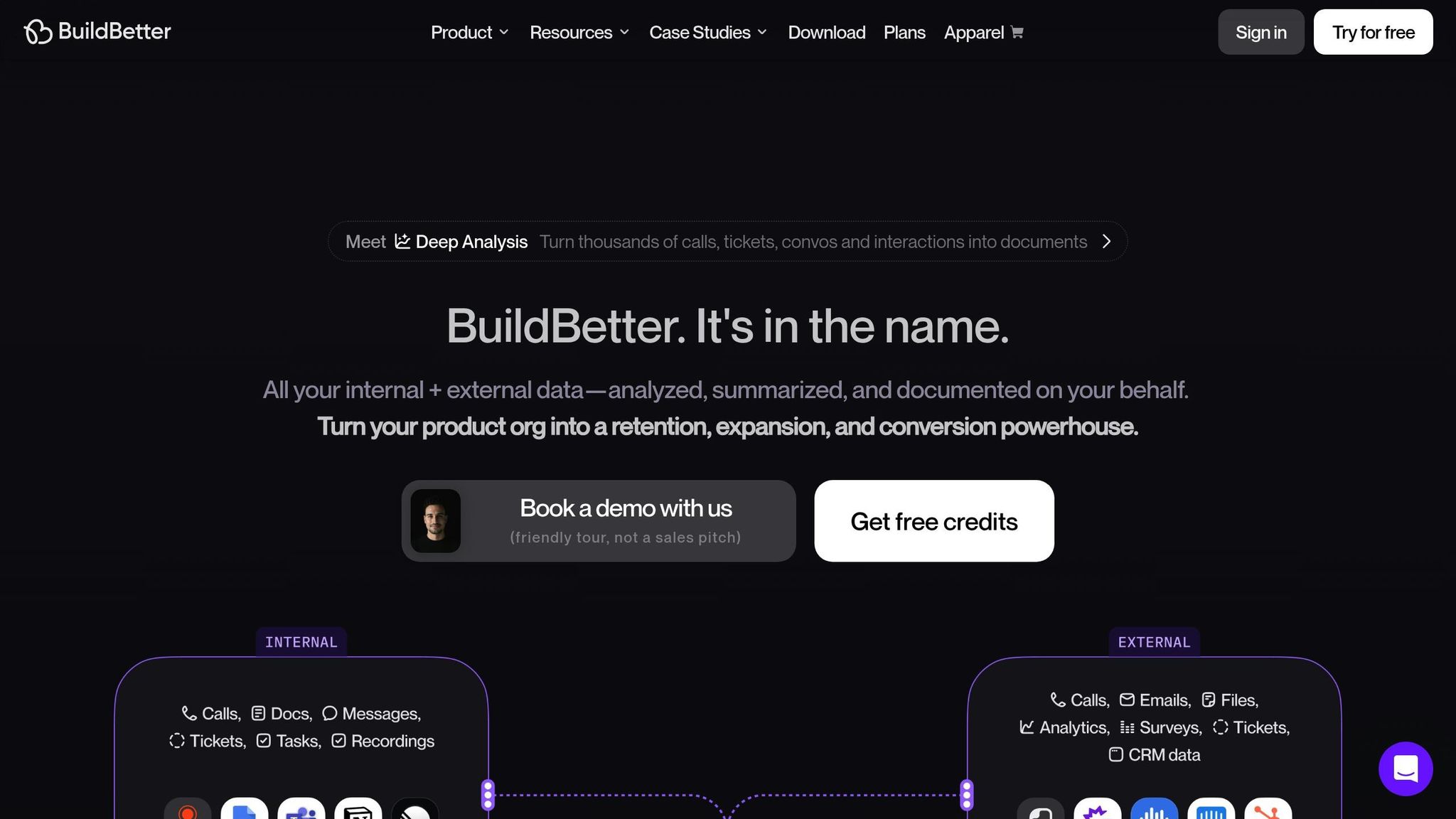
BuildBetter.ai is an AI-powered insights platform designed to help B2B product teams turn scattered data into actionable decisions for their product roadmaps. Unlike traditional tools that focus mainly on planning and visualization, BuildBetter.ai goes a step further by integrating internal team communications with external customer feedback. This combination offers a complete view for shaping product strategies, setting the stage for advanced AI-driven features.
The platform brings together three essential functions: team call recording, B2B qualitative analysis, and B2B AI chat. These tools allow teams to pull insights from conversations, internal discussions, and feedback channels, organizing unstructured data into structured, research-ready documents for roadmap planning.
AI-Driven Roadmap Management
BuildBetter.ai uses AI to streamline and enhance every stage of roadmap management. Its AI capabilities automate roadmap creation and suggest prioritization based on user feedback and historical data, helping teams stay flexible and focused.
The platform also offers predictive insights for release planning and includes analytics dashboards to monitor roadmap progress, feature adoption, and team performance. Teams receive AI-generated reports highlighting customer feedback trends, potential risks for upcoming releases, and forecasts for delivery timelines and resource allocation.
What sets BuildBetter.ai apart is its emphasis on delivering meaningful insights. While many tools process large volumes of low-quality data, BuildBetter.ai focuses on transforming qualitative inputs into structured, high-value insights that directly influence product decisions.
Seamless Integration with Popular Tools
BuildBetter.ai integrates with over 100 widely-used tools, including Jira, Slack, Salesforce, Zendesk, HubSpot, and Intercom. These integrations simplify workflows by reducing manual data entry and ensuring all team members have access to the latest information.
- Jira Integration: Automatically syncs issues and epics, keeping roadmap items updated with development progress.
- Slack Integration: Provides real-time notifications and collaboration tools, ensuring distributed teams stay aligned.
- Salesforce Integration: Brings in customer feedback and aligns product strategy with sales insights, bridging the gap between market needs and product planning.
The platform’s bot recorder works seamlessly with tools like Zoom, Microsoft Teams, Google Meet, and Webex. It also offers a mobile app for recording both in-person and remote conversations, ensuring valuable insights are captured wherever teams are working.
Collaboration Tools for Cross-Functional Teams
BuildBetter.ai supports cross-functional collaboration with features like shared workspaces, real-time commenting, role-based access, and collaborative roadmap editing. Teams can assign tasks, track progress, and gather feedback from stakeholders directly within the platform, promoting transparency and efficient decision-making across product, engineering, marketing, and sales teams.
With its focus on permission management and automated organization, the platform ensures sensitive information is shared securely with the right stakeholders. Customizable workflows and automated project briefs help keep everyone aligned on roadmap priorities and progress.
One mid-sized SaaS company shared their success story: by integrating BuildBetter.ai with Jira and Slack, they cut manual updates by 40% and improved team alignment, resulting in a 25% faster release cycle and better customer satisfaction scores.
Pricing Plans for US-Based Teams
BuildBetter.ai offers flexible pricing plans designed for teams of all sizes, with costs listed in US dollars and aligned with standard US billing practices.
| Plan | Price | Minutes Included | Key Features |
|---|---|---|---|
| Starter | $7.99/month | 120 minutes | Unlimited seats, 1 report, 1 workflow, 1 custom document |
| Growing | $200/month | 3,600 minutes | Unlimited seats, unlimited reports, workflows, custom documents |
| Scaling | $800/month | 16,000 minutes | Everything in Growing plus advanced features |
| Enterprise | Custom pricing | Unlimited | Advanced privacy, custom SSO/SAML, dedicated success team |
For additional usage, extra minutes cost $0.10 each on the Starter plan, decreasing to $0.06 per minute on the Scaling plan. External feedback processing is billed at $0.65 per piece on Starter and $0.35 per piece on Scaling plans.
BuildBetter.ai adheres to major US data protection standards like SOC 2 and GDPR, using encryption for data both at rest and in transit. Features like audit logs, role-based permissions, and secure API connections ensure that integrations don’t compromise sensitive product information.
2. Productboard
Productboard, much like BuildBetter.ai, focuses on customer-driven prioritization but adds its own spin with a platform designed to streamline product management. It helps teams organize customer feedback, prioritize features, and create clear visual roadmaps that bring stakeholders on the same page.
By bringing everything under one roof - feature prioritization, roadmap creation, and stakeholder communication - teams can gather feedback, assess user needs, and turn those insights into actionable plans.
Integration Capabilities with Popular Tools
Productboard connects seamlessly with widely-used tools like Jira for syncing development tasks, Slack for instant feedback sharing, and Salesforce, Zendesk, and Intercom for pulling customer data directly into the planning process. These integrations ensure development teams have the context they need to understand why certain features take precedence.
Collaboration Features for Cross-Functional Teams
Collaboration is a breeze with Productboard’s features. Teams can use customizable views tailored for executives or engineers, real-time commenting to cut down on endless email threads and meetings, and an audit trail to keep track of how priorities evolve over time.
Pricing Plans for the US Market
Productboard offers pricing options designed to fit teams of all sizes. Whether you’re a small team testing the waters or a larger organization needing advanced tools and dedicated support, there’s a plan for you. All pricing is listed in US dollars. For the latest details, check out Productboard's official website.
3. Aha!
Aha! is a robust product management platform that bridges the gap between big-picture strategy and detailed execution, offering teams a structured way to align their goals with actionable plans.
The platform excels at strategic alignment, enabling teams to craft detailed product strategies, set measurable goals, and build roadmaps that directly support those objectives. This approach ensures every feature and initiative contributes to broader business priorities.
Integration Capabilities with Popular Tools
Aha! integrates smoothly with a wide range of development and business tools. Its Jira integration is particularly noteworthy, allowing teams to send features and requirements directly to development sprints while keeping a clear link to strategic goals.
The platform also connects with over 30 other tools, including Slack, Salesforce, Azure DevOps, GitHub, and Tableau. These integrations make it easy to fit Aha! into most existing tech stacks, improving workflows and fostering collaboration across teams.
Collaboration Features for Cross-Functional Teams
Aha! enhances collaboration with features designed for cross-functional teams. The presentation mode automatically transforms roadmaps into views tailored for different stakeholders - executives can see high-level timelines, while developers access detailed specifications.
Additional collaboration tools include @mentions for direct communication within roadmap items, approval workflows for feature sign-offs, and shared workspaces where marketing, sales, and development teams can work together on product plans. Real-time commenting and activity feeds ensure everyone stays updated on changes and decisions.
Pricing Plans for Product Teams in the US Market
Aha! offers tiered pricing in US dollars, billed annually. Plans range from basic roadmapping tools to more advanced features like custom reporting, strategy tools, and dedicated support. A 30-day free trial is available for teams looking to test the platform.
For larger companies, enterprise plans provide advanced security features, single sign-on, and priority support - key elements for meeting compliance requirements and ensuring smooth operations.
4. Roadmunk
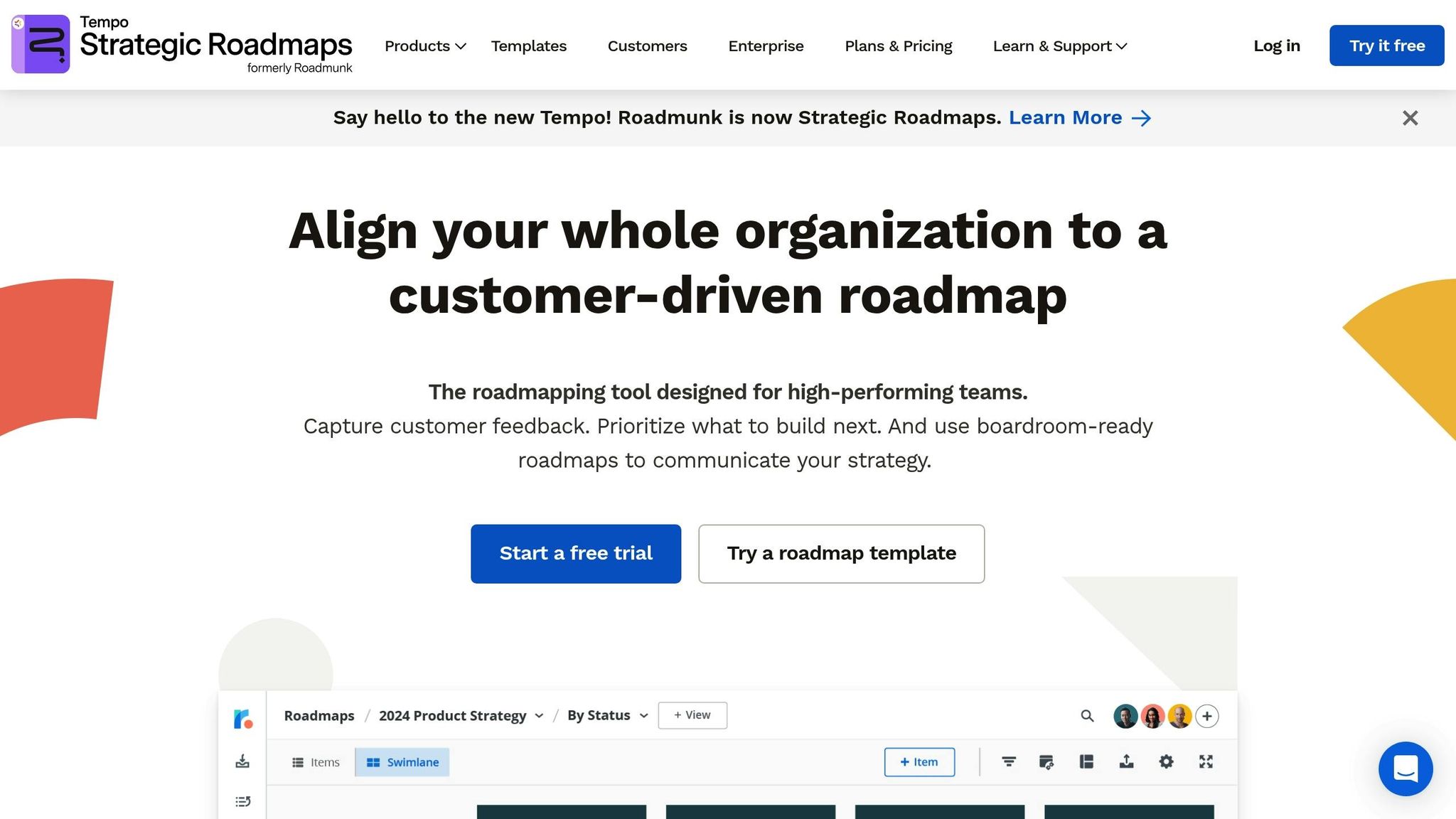
Roadmunk specializes in creating visually appealing and adaptable roadmaps, offering a variety of formats to suit different audiences. With options like timeline views, swimlane layouts, and Kanban-style boards, it ensures that roadmaps are easy to understand and accessible to everyone, from technical teams to executives. This visual-first approach aligns well with strategies found in other tools, focusing on simplicity and clarity.
One of Roadmunk's standout features is its advanced visual planning capabilities. Product managers can use its flexible formats to effectively communicate plans and strategies, tailoring presentations to resonate with both technical experts and decision-makers.
Another key feature is its feedback management system. This tool gathers input from multiple sources, making it easier to prioritize features by combining customer feedback with internal insights. This ensures that product decisions are well-informed and aligned with user needs.
5. ProdPad
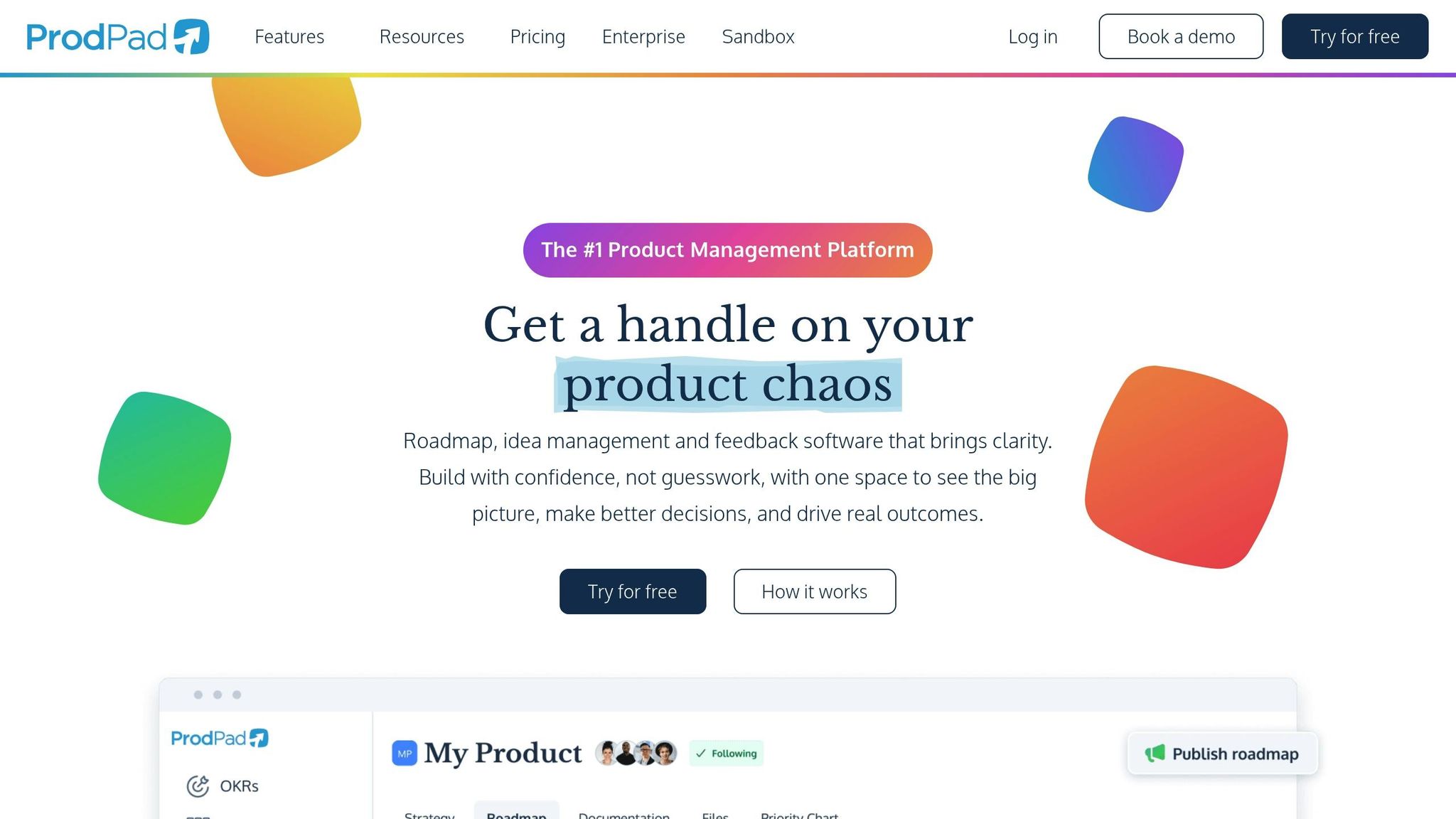
ProdPad is designed to simplify product strategy by combining roadmapping, idea management, and feedback collection into one streamlined platform. It supports agile teams by focusing on lean, ongoing discovery and validation, helping them make smarter, data-driven decisions.
The platform’s idea management system is particularly handy - it collects ideas from multiple sources and evaluates them systematically to determine their fit for the roadmap. This process ensures that only well-considered and thoroughly vetted ideas make it to the development stage.
ProdPad also integrates seamlessly with popular tools like Jira and Slack, ensuring teams stay connected and maintain clear traceability throughout the product lifecycle.
Collaboration is another key highlight. ProdPad encourages teamwork across departments by fostering focused discussions and gathering input from product, engineering, sales, and customer success teams. This collaborative dynamic aligns everyone toward agile planning and smooth roadmap execution.
With flexible pricing options that adapt to various team sizes and needs, ProdPad is accessible to organizations of all types. For the latest details on its features, integrations, and pricing, check out the official ProdPad website.
6. Airfocus
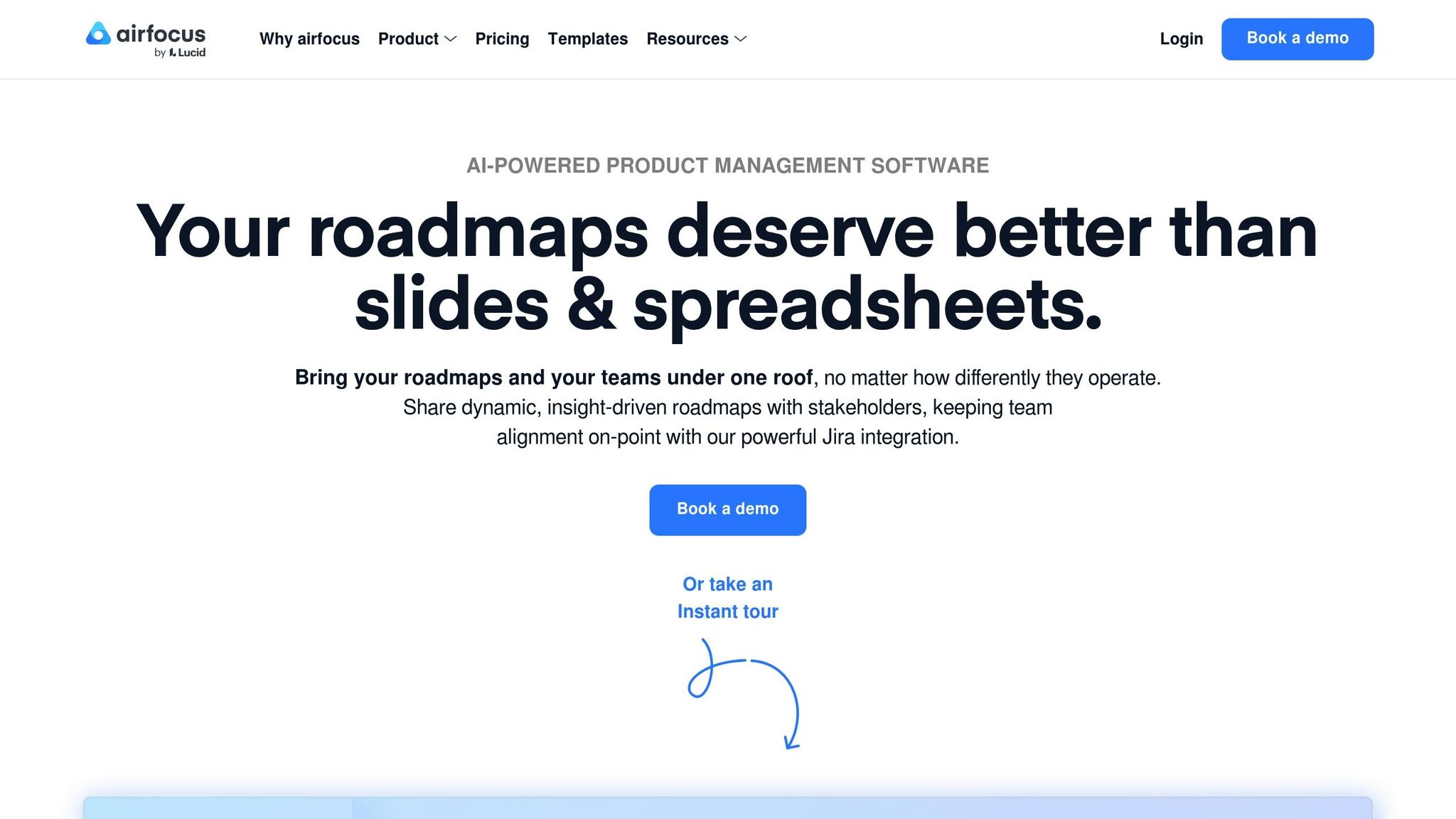
Airfocus brings a modern twist to roadmapping with its AI-powered platform, designed to make planning more efficient and effective. Its standout feature, AI Assist, uses simple slash commands to help you tackle key tasks, such as:
- Creating a complete roadmap that includes vision, timelines, and dependencies.
- Conducting market and competitor research to inform your strategy.
- Producing detailed descriptions for features and milestones.
In addition to these tools, Airfocus offers objective backlog prioritization by leveraging data-driven insights. This AI-driven approach aligns perfectly with agile decision-making, making it a valuable addition to the lineup of top roadmapping tools.
7. Craft.io
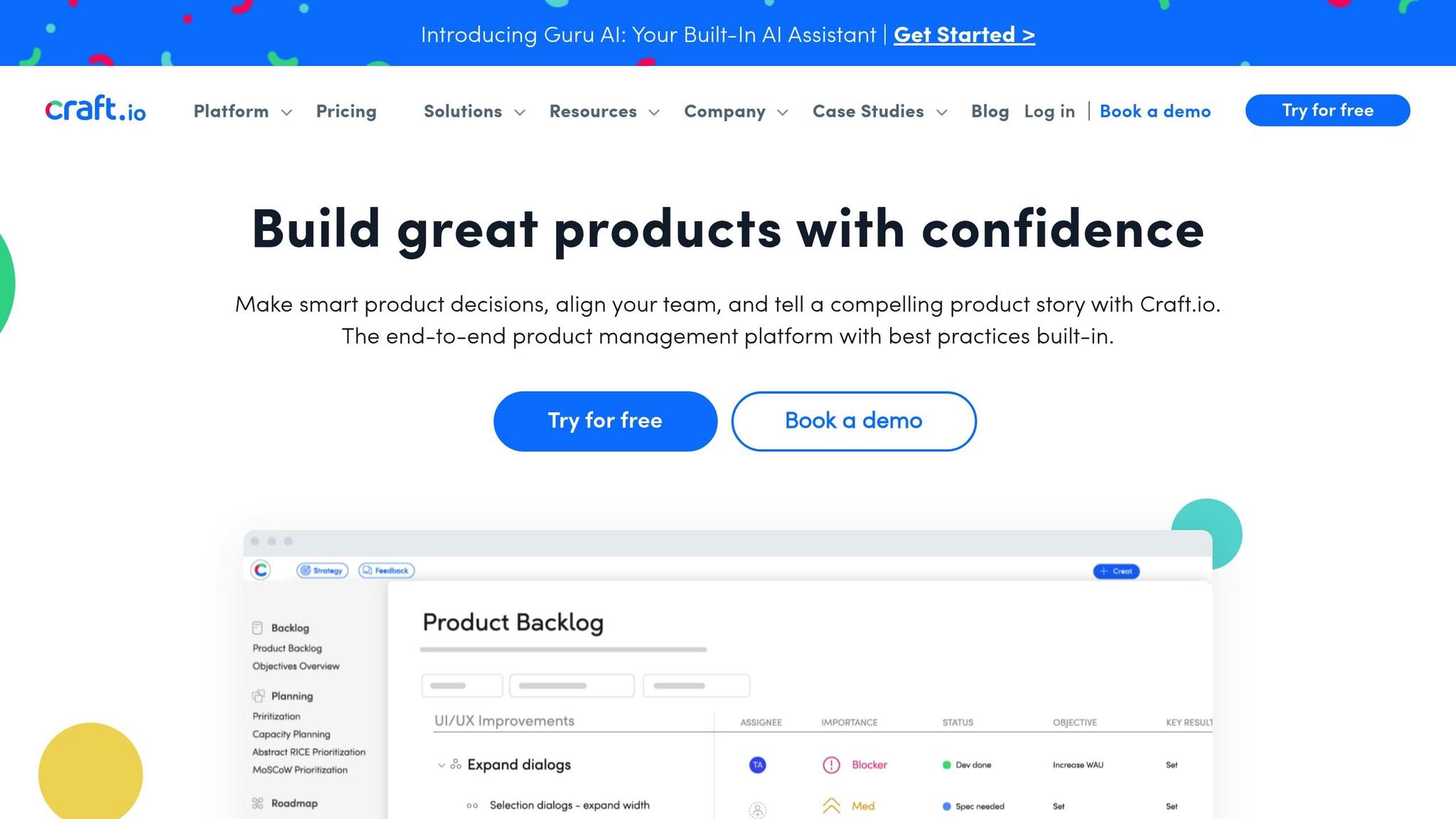
Craft.io is a product management platform designed to bridge the gap between strategy and execution. It goes beyond simple roadmapping by offering tools that help teams connect their planning directly with development processes. With features like drag-and-drop roadmap editing, real-time collaboration, and smooth integrations with other tools, Craft.io simplifies workflows and keeps teams aligned. Its all-in-one approach makes it a valuable resource for coordinating cross-functional teams before moving into more specialized tools.
8. Asana
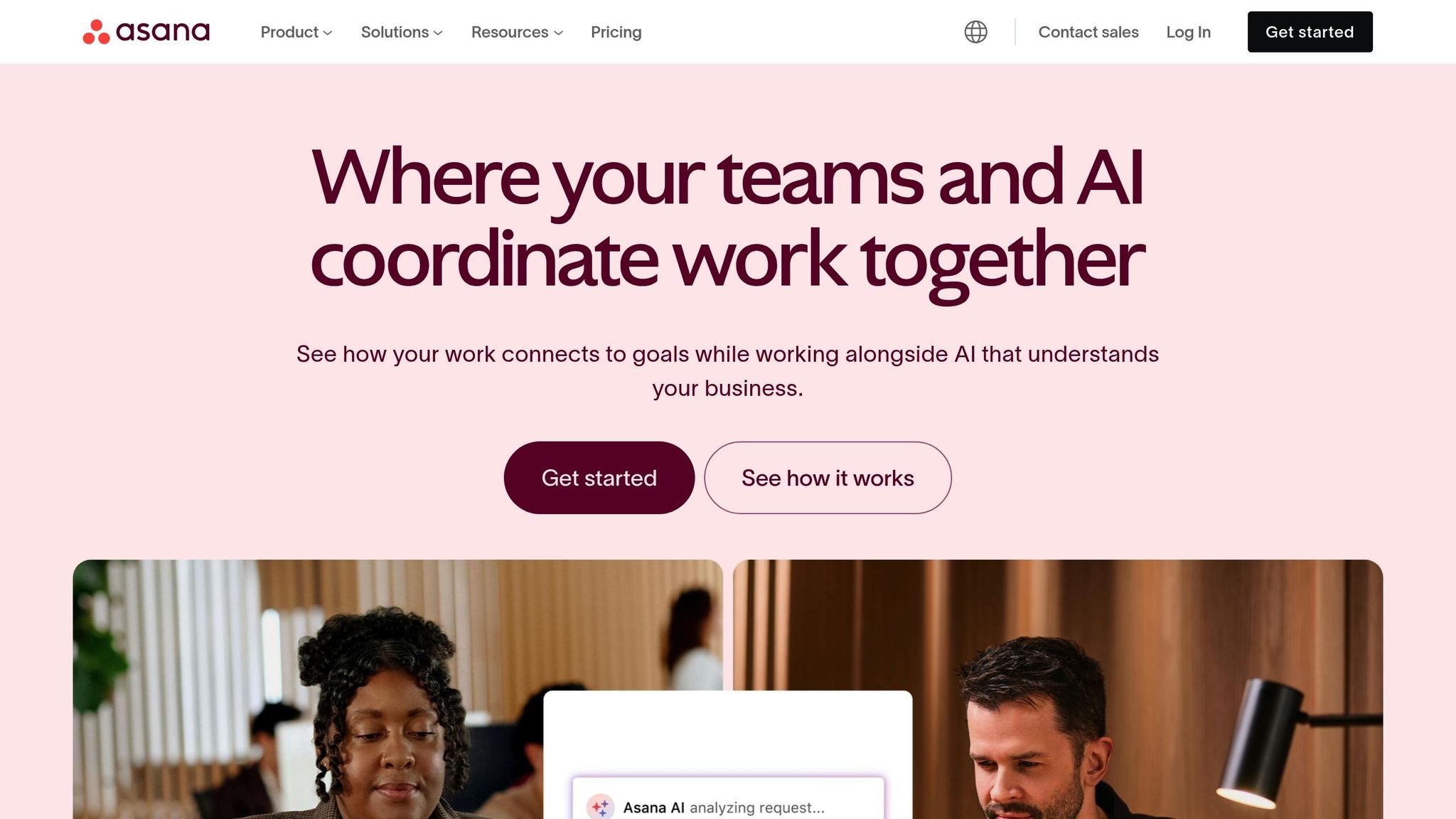
Asana offers a fresh take on project management, providing tools that make strategic planning and execution more intuitive. While it's widely recognized as a project management platform, its Timeline view and Portfolio features stand out for helping teams map out product development from start to finish.
These features bring clarity to planning and task management. With Asana, complex projects can be broken into manageable tasks and milestones. The Timeline view, presented in a Gantt chart format, is particularly useful for creating high-level roadmaps. It allows teams to identify bottlenecks and adjust schedules as priorities shift, making it easier to stay on track.
Collaboration Features for Cross-Functional Teams
Asana excels at bringing cross-functional teams together. Designers can share mockups, developers can monitor progress, and everyone stays in sync thanks to integrations with tools like Jira and Slack, which provide real-time updates.
The Goals feature helps align roadmap activities with broader business objectives. Teams can set measurable targets and track progress across multiple projects, showing how individual tasks contribute to larger company goals.
To simplify roadmap creation, Asana offers custom fields and project templates. These tools standardize the way teams document feature requirements, acceptance criteria, and success metrics. This consistency is especially helpful during quarterly planning or when onboarding new team members.
Integration Capabilities with Popular Tools
Asana integrates effortlessly with many popular tools. For example, the Jira integration syncs epics and user stories, ensuring updates stay consistent. The Slack integration sends roadmap updates directly to team communication channels, keeping everyone informed.
For teams working closely with sales and customer success, the Salesforce integration is a game-changer. Feedback and feature requests captured in Salesforce can flow directly into Asana projects. This helps product managers prioritize roadmap items based on real customer needs and their potential impact on revenue.
Pricing Plans Tailored for Product Teams in the US Market
Asana’s pricing options are designed to fit teams of all sizes and needs.
- The Basic plan is free for up to 15 users, making it a great starting point for smaller teams.
- The Premium plan, priced at $10.99 per user per month, includes essential features like the Timeline view, custom fields, and advanced search capabilities. It also offers reporting tools that help product managers share progress with stakeholders.
- For larger teams, the Business plan costs $24.99 per user per month. This tier adds Portfolio management and advanced integrations, which are ideal for managing multiple product lines or coordinating roadmaps across departments. It’s a robust option for product leaders aiming to show how team roadmaps align with the company’s broader strategy.
Whether you're part of a small team or a large organization, Asana provides tools to keep everyone aligned and focused on delivering results.
9. Visor
Visor blends the simplicity of spreadsheets with the power of databases to create a tool perfect for advanced roadmap planning. It’s designed to handle complex product data with ease, offering a dynamic platform that adapts to changes in priorities, resources, or timelines - cutting down on those tedious manual updates.
Integration Capabilities with Popular Tools
Visor works effortlessly with popular tools to streamline your workflow. Its Jira integration ensures project data stays up-to-date, while Slack sends automated milestone notifications to keep teams in the loop. Plus, Salesforce integration allows customer feedback to flow directly into your roadmap, making collaboration across teams smoother than ever.
Collaboration Features for Cross-Functional Teams
With Visor’s shared workspace, teams from engineering to marketing can work together seamlessly. Everyone can update specs, attach files, and set deadlines in a single, unified view. The built-in comments feature captures feedback in real time, ensuring nothing gets lost in translation.
Flexible Pricing Options
Visor offers pricing plans to suit teams of all sizes. Whether you’re looking for essential roadmap tools, advanced automation, or premium integrations, there’s a plan designed to meet your needs.
10. ProductPlan
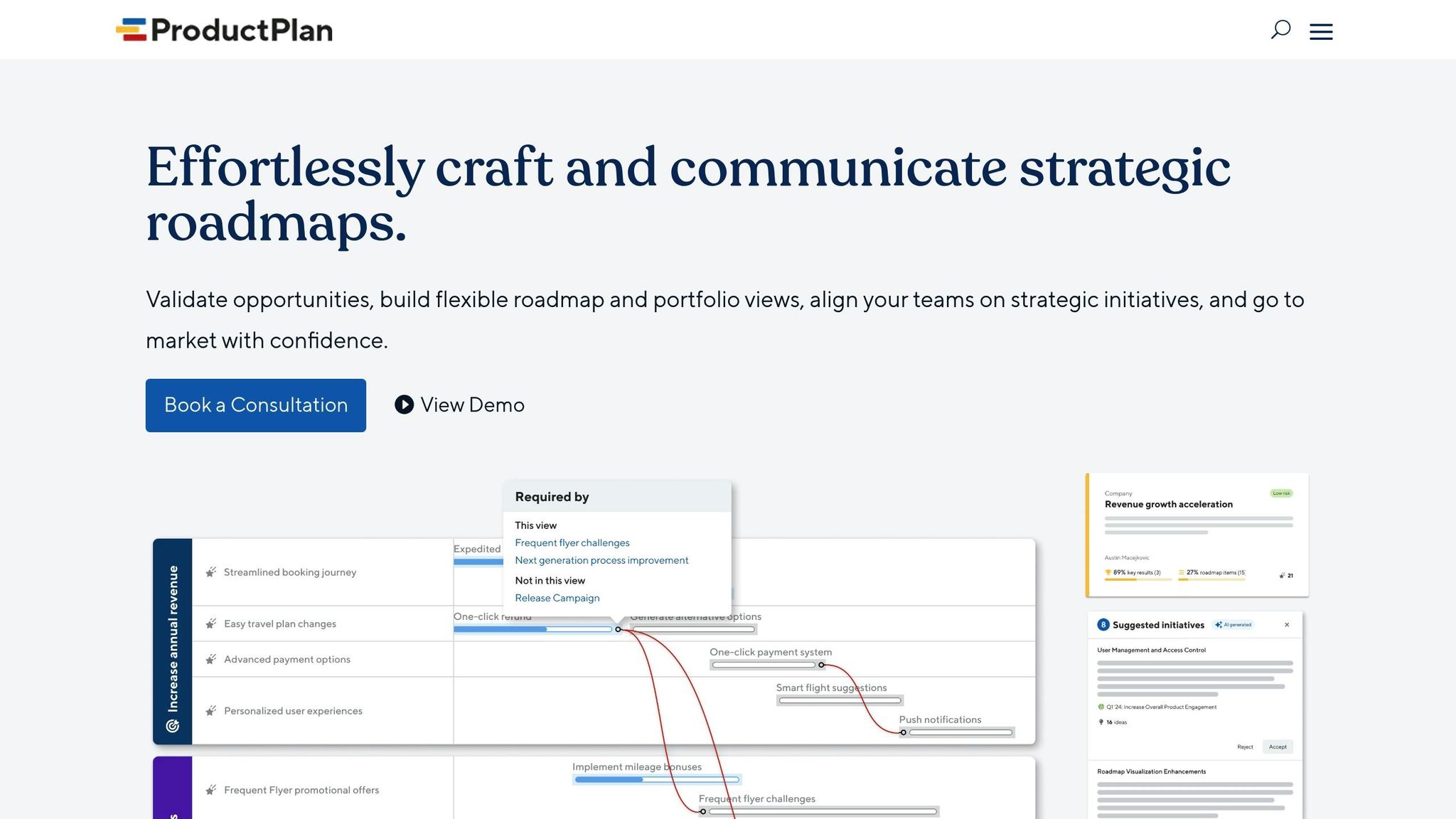
ProductPlan focuses on collaboration, helping cross-functional teams stay aligned. Its intuitive drag-and-drop interface allows teams to adjust priorities and content effortlessly, while shared roadmap views ensure everyone has access to the same up-to-date information.
Integration Capabilities with Popular Tools
ProductPlan integrates smoothly with tools your team already relies on. With the Jira integration, users can link directly to Jira issues from their roadmaps, keeping development teams aligned without toggling between platforms. Through Zapier, you can automate tasks like creating Jira issues or sending Slack notifications, reducing manual work and ensuring roadmaps are always current.
The Slack integration sends instant notifications when roadmap changes or comments occur, keeping everyone informed. Teams can also dive into discussions directly within ProductPlan.
For sales teams, the Salesforce integration ensures seamless data syncing. Ideas from Salesforce can flow into ProductPlan automatically, and updates to roadmap bars in ProductPlan can reflect in Salesforce Essentials via Zapier. This automation eliminates mismatched data and keeps your workflow consistent across platforms.
Collaboration Features for Cross-Functional Teams
In addition to its powerful integrations, ProductPlan enhances team communication. The shared roadmap views provide a clear, unified perspective for all team members. Features like commenting on roadmap items and receiving real-time updates make decision-making faster and more transparent - no need for endless email threads. Plus, roadmaps can be shared with anyone, whether they’re part of your organization or external stakeholders, ensuring everyone stays informed and aligned.
11. Jira Advanced Roadmaps
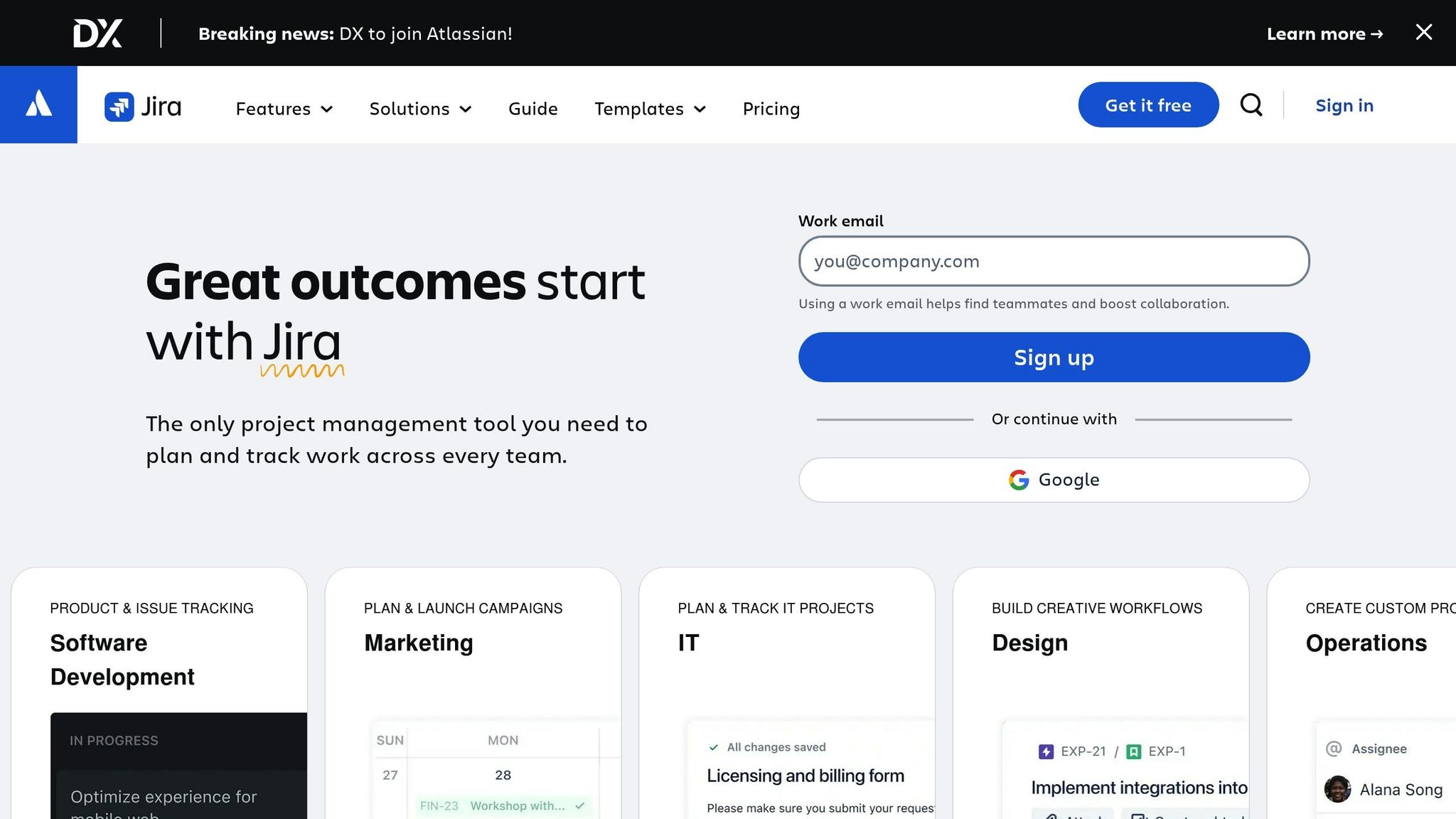
Jira Advanced Roadmaps is a powerful planning tool designed for teams using Atlassian. It transforms complex project structures into clear visual guides, helping teams track progress across multiple initiatives and manage dependencies effectively.
With this tool, product managers can map epics, stories, and tasks across teams and timelines. It provides a structured way to create roadmaps, connecting high-level initiatives to individual tasks. This clarity supports better planning and ensures everyone stays aligned.
Integration Capabilities with Popular Tools
Jira Advanced Roadmaps works seamlessly with the entire Atlassian suite, making it easy to manage everything in one place. Since it’s built into Jira, it handles issue tracking, sprint planning, and roadmap visualization without requiring manual data syncing between different platforms.
The tool also integrates with Confluence for documentation and Bitbucket for code management. Teams can link roadmap items to Confluence pages for technical details or track progress through Bitbucket commits, bridging the gap between strategic planning and actual development work.
For team updates, Slack notifications keep everyone in the loop about roadmap changes. This feature is especially useful for distributed teams, allowing them to stay updated on shifting priorities and timelines without needing to constantly check the roadmap.
Collaboration Features for Cross-Functional Teams
Jira Advanced Roadmaps offers scenario planning, allowing teams to test different resource allocations and timelines. This feature is invaluable during quarterly planning, as it helps product managers see how staffing changes or shifting priorities might affect delivery dates. Visual dependency mapping further highlights areas where bottlenecks could occur, enabling teams to address risks before they escalate.
The tool also improves cross-team collaboration with shared roadmap views. These views can be tailored to different audiences - executives can focus on high-level milestones, while development teams can dive into sprint-specific details. This flexibility ensures that everyone gets the information they need without unnecessary distractions.
Tool Comparison Table
Here's a quick glance at 11 tools, comparing their features, pricing, AI capabilities, integrations, and ideal use cases. Use this table as a guide to match your team's requirements with the right tool.
| Tool | Key Features | Starting Price (USD) | AI Capabilities | Top Integrations | Best Use Case |
|---|---|---|---|---|---|
| BuildBetter.ai | AI-driven insights, call recording, qualitative analysis, B2B chat, automated workflows | $7.99/month | Advanced AI for data analysis, automated documentation, and meeting summaries | Zoom, Slack, Jira, Salesforce, HubSpot, Intercom, Linear, Notion | Teams prioritizing data-driven insights |
| Productboard | Custom roadmaps (agile, Kanban, timeline), centralized feedback, feature prioritization | $25/month | Basic AI for feedback categorization | Jira, Slack, Zendesk, Salesforce, GitHub | Product teams integrating customer feedback into planning |
| Aha! | Strategic planning, goal tracking, release management, idea management | $74/month | Limited AI features | Jira, Azure DevOps, Salesforce, Slack | Enterprise teams needing strategic roadmap alignment |
| Roadmunk | Timeline roadmaps, swimlane views, milestone tracking, presentation mode | $19/month | No AI capabilities | Jira, Trello, Azure DevOps, CSV imports | Teams focused on visual roadmap presentations |
| ProdPad | Idea management, feedback collection, roadmap planning, product discovery | $24/month | Basic AI for idea clustering | Jira, Trello, Slack, Intercom, UserVoice | Small to medium teams focused on iterative product planning |
| Airfocus | Priority scoring, modular roadmaps, OKR tracking, portfolio management | $19/month | AI-powered priority scoring | Jira, Azure DevOps, Slack, Zapier | Teams needing flexible prioritization frameworks |
| Craft.io | Spec management, roadmap planning, stakeholder alignment, delivery tracking | $39/month | No AI capabilities | Jira, GitHub, Slack, Figma, Confluence | Development teams requiring detailed specifications |
| Asana | Project management, timeline view, goal tracking, team collaboration | $13.49/month | AI-powered automation and insights | Slack, Microsoft Teams, Adobe Creative Suite, Salesforce | Cross-functional teams managing multiple projects |
| Visor | Spreadsheet-style interface, data visualization, workflow automation | $20/month | Basic automation features | Google Sheets, Airtable, Notion, Zapier | Teams comfortable with spreadsheet-based planning |
| ProductPlan | Drag-and-drop roadmaps, timeline management, stakeholder sharing | $49/month | No AI capabilities | Jira, Azure DevOps, Slack, PivotalTracker | Teams needing simple, clear roadmaps |
| Jira Advanced Roadmaps | Dependency mapping, scenario planning, cross-team coordination | $7.16/month (part of Jira Premium) | No AI capabilities | Atlassian suite, Slack, Confluence, Bitbucket | Development teams using the Atlassian ecosystem |
Key Takeaways
- Pricing: Tools like BuildBetter.ai and Jira Advanced Roadmaps are budget-friendly, starting under $10/month. However, Jira Advanced Roadmaps is part of the broader Jira Premium package.
- AI Features: BuildBetter.ai stands out with advanced AI for data analysis and smart meeting summaries, while others like Productboard and ProdPad offer basic AI for specific tasks like feedback categorization.
- Integrations: BuildBetter.ai leads with over 100 integrations, while Jira Advanced Roadmaps fits seamlessly into the Atlassian suite. Other tools focus on essential integrations with development platforms.
- Feature Variety: Options range from simple visual tools like ProductPlan to comprehensive platforms like Aha! and BuildBetter.ai.
Ultimately, the best tool depends on your team's size, goals, and workflow. Startups or small teams may find BuildBetter.ai ideal for its feature-packed, budget-friendly platform, while larger enterprises might prefer Aha! for its strategic planning capabilities. Meanwhile, development-heavy teams already using Atlassian tools often stick with Jira Advanced Roadmaps for its seamless integration.
Conclusion
The right roadmap tool can make a big difference in how teams plan, prioritize, and communicate. Each of the 11 tools covered in this guide offers distinct features - ranging from AI-driven insights to platforms with extensive strategic planning capabilities.
Choosing the best tool comes down to your team’s specific needs. Smaller teams often benefit from budget-friendly, feature-packed options, while development-focused teams might prefer tools that integrate seamlessly with Atlassian products. Larger enterprises looking for strong alignment across departments may lean toward platforms designed for comprehensive strategic planning.
Each tool has its strengths and ideal use cases. Consider factors like team size, budget, current tools, and workflow requirements. For example, teams focused on customer feedback might prioritize tools designed to integrate that input effectively. On the other hand, those needing adaptable prioritization frameworks or visually appealing timelines may look for solutions that excel in those areas.
Roadmap tools are also evolving, with AI becoming a key feature. Some platforms are already leveraging advanced AI for smarter planning, while others are gradually adding basic AI functionalities.
To make the best choice, identify your team’s challenges, required integrations, and long-term objectives. Take advantage of free trials to test how well a tool aligns with your needs. Whether you’re a startup building your first roadmap or a seasoned team upgrading your current process, the right tool can enhance efficiency and improve alignment with stakeholders.
FAQs
What should I look for in a product roadmap tool to best suit my team?
When choosing a product roadmap tool, it's important to prioritize a few essential aspects. Start with ease of use - a tool that's intuitive can save your team time and effort. Next, check its integration capabilities to ensure it works seamlessly with the tools you already rely on. Also, evaluate how well it aligns with your team’s workflows and supports their goals.
Think about features that encourage collaboration, make updates straightforward, and adapt as your team grows. Don’t forget practical considerations like your team’s familiarity with similar tools, your budget, and how well the tool fits into your overall product strategy. A good roadmap tool should simplify planning, help you set priorities, and improve communication so everyone stays aligned.
How do AI features improve product roadmap planning and execution?
AI-powered features in product roadmap tools make planning and execution smoother by providing smart automation and actionable insights. These tools dig into elements like customer feedback, market trends, and business impact to recommend priorities that align with your strategic objectives.
With AI, teams can process massive datasets in no time, spot patterns, and make decisions with greater confidence. This approach minimizes guesswork and ensures resources are used efficiently, enabling product teams to achieve more consistent and meaningful results.
Do these product roadmap tools work with software like Jira or Slack?
Many product roadmap tools work effortlessly with platforms like Jira and Slack, making it easier for teams to align their workflows. By linking roadmaps with Jira, teams can sync roadmap items with issue tracking, ensuring updates happen in real-time. Slack integrations, on the other hand, help streamline communication by sending notifications or updates whenever changes are made to the roadmap.
For instance, you can connect specific roadmap items to Jira tickets, keeping everyone informed as tasks progress. Similarly, Slack alerts ensure that team members are instantly aware of any adjustments, fostering smoother collaboration and increased efficiency.